Its farmers who are now rediscovering NSW’s enduring CMTs & finding ways to safeguard them. We aren’t getting much help with state Govt. legislation lagging well behind what is required. The only CMTs protected within NSW’s guidelines are the ordinary scarred trees. Ringtrees, TinTs, culturally burnt trees, birthing trees, translocated trees/ shrubs etc – are not recognised or protected without Indigenous suggestion. When the local Land council or Elders group doesn’t want to be involved, there is little we can do. It’s not a big issue here at Walgett because we don’t have the Inland rail coming thru or a huge solar farm planned – yet? I still have faith in the ancestors & their descendants to work this out. Allan Tighe is a strong believer in psychic payback. Karma is not a word apparently, it’s a sentence …
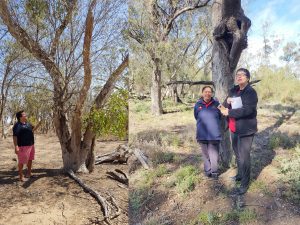
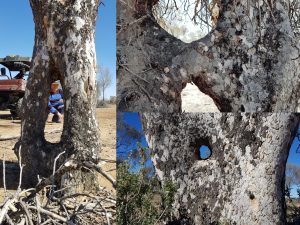
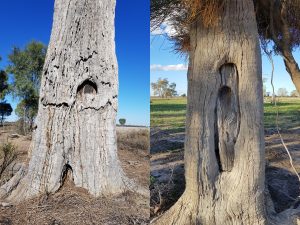
NONE OF THE TREES ABOVE HAVE ANY PROTECTION UNDER THE LAW – ASK THE ELDERS WHY NOT?
You would not believe the scarred trees around the Gali gurranaa camp at Cumborah – breathtakingly beautiful set you on your backside types – figuratively speaking obviously, because of the Hudson pear cactus – but you know what I mean. Like the wells here at Murra-manaarr the Cumborah springs provided permanent water. The springs are still used today unlike the underground water in the sandhills but the quality is incomparable. Apparently the main aquifer was destroyed while constructing roads and other town infrastructure but the TinTs pinpoint the site. This one below is incredible ..3 separate mature guests of different species – rosewood, supplejack & something else I can’t identify but maybe budda? Lots of birdshit dropping from the sky around Cumborah apparently?
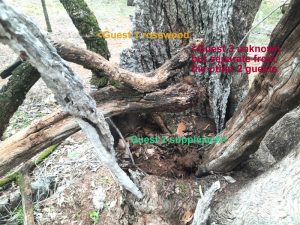
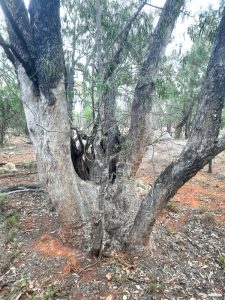
Also been back to the Ginghet Nature Reserve with Sandra & her bloke Roger last week. So much better walking with others – 3 pairs of eyes to start with. Sandra has a much broader range of cultural knowledge than I do. I’m really only interested in the old traditions in so far as they are displayed on/ in the trees. My enthusiasm for scarred trees led to my interest in ringtrees which in turn developed into a full blown obsession with Trees in Trees. You need to see a lot of CMTs before you can get your head around TinTs. I have a short video I took some years ago of Allan & I on the neighbour’s place where he grew up. Im asking how they chipped the flakes off the stone cores for skinning animals. Allo is demonstrating while standing in front of a big old box with multiple deep coolamons and an old rosewood guest inside – neither of us noticed the rosewood. I was fixated on the number & depth of the coolamons on the box trunk & Allo was focusing on the artefacts. As Ive said before you can’t see this until you’ve mentally assimilated that. Go to the historical permanent waters in your area and LEARN TO LOOK 👀
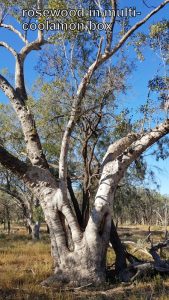
Perhaps that’s why academics wont accept the TinTs as cultural creations? Firstly they are never out in NthWest NSW unless they are working at known sites like Narran lakes or Cuddie springs. These were meeting/ ceremonial/ trading places that came alive with flood water. Academics never wander around in the bush looking at trees on spec & often have a warped perception of farmers as destroyers not preservers. They meet only with the Aboriginal Elders groups or Land councils who are not living in the bush either. Ive had to explain to would-be ‘experts’ that historically, tree clearing has been illegal in the western division of NSW (about one third of the state) This is leasehold land & those leases can be revoked for agricultural crimes such as overgrazing or unregulated development. Aboriginal cultural excursions & Welcome to country performances go to the same places every year as well. Clueless and condescending city dwelling ecologists are simply unwilling to concede there’s a wealth of relatively undisturbed landscapes out here that they know bugga all about.
The exception to the rule, rangeland ecologist Dr Jen Silcock, mentioned to me at the Albany noongar boodjar conference (haha listen to me – sounding like a total academic lol ..) that Gingie was the only place she knew that had leopardwood ringtrees. There are a few Ive bumped into on weilwun country but most are scattered here or around the natural water catchment on Avon. So restrain your disbelief for a moment & look at these pics below. I reckon they have used young neighbouring trees or vines to maintain the gaps in the leopardwood trunks? Possibly threaded through holes made with a sharp tool/ stick? The last one looks accidental but there are 2 other ringtrees in that group of less than a dozen leopardwoods. Those of you who don’t accept anthropological woody epiphytes won’t believe these rings are cultural either
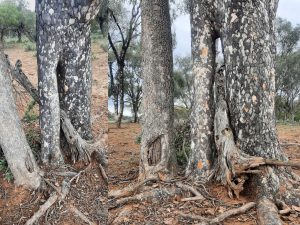
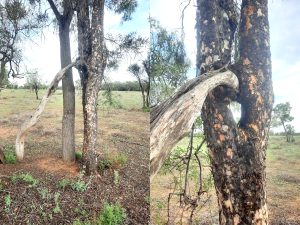
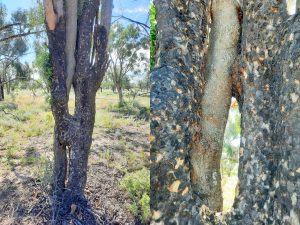
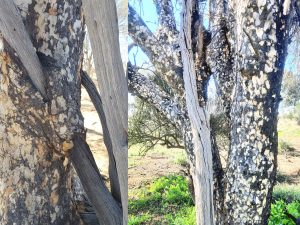
I would also like to use this blog to show the sceptics the episodic nature of some guests which explains a couple of the size issues. Below is a VinT (Vine in Tree) in a steel axe cut crotch. When I first noticed this VinT just across the road in 2016, the gargaloo vine (Parsonsia eucalyptophylla) was alive but just a stub about 30 cm long. The green shoot died off & by 2018 the vine appeared dead. Ive checked on this VinT on & off while mustering – seen here in 2021. The dead gargaloo stub had dropped off by 2022 and it was to all intents & purposes an empty crotch. Very surprised to see this gargaloo vine appear again a few months ago – the last pic showing how it looks now.
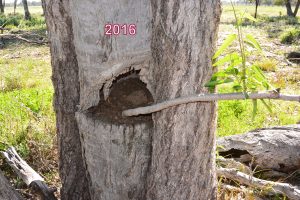
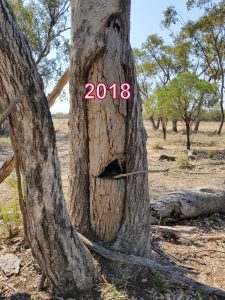
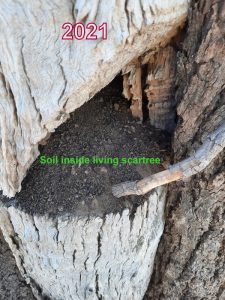
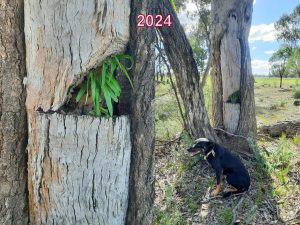
Another Lazurus guest Ive talked about is the rosewood (Alectryon oleifolius) The bimblebox crotch below used to be overflowing with Thorny saltbush (Rhagodia spinescens) A few years ago I noticed a Pimelea microcephala in there as well. Mustering yesterday I realised the old saltbush had died away completely & there was actually a rosewood growing in that crotch too. Interestingly there is another rosewood growing in a coolabah about 10 metres away – weird for a tree that’s extremely difficult to germinate from seed? If anyone has an alternative non Indigenous explanation as to how these bunbarr trees got into these old eucalypt crotches I would love to hear it …
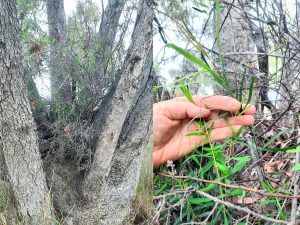
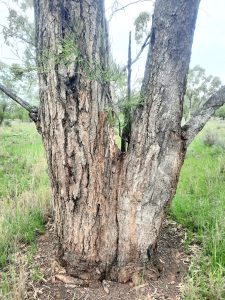
Australians don’t have any problem accepting that Japanese people were doing this 500 years ago
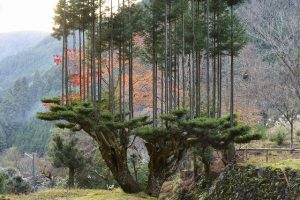
But cant accept our own Aboriginal people were doing this.
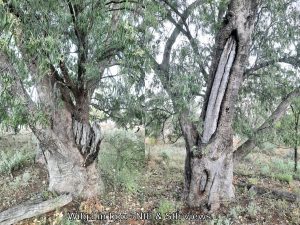
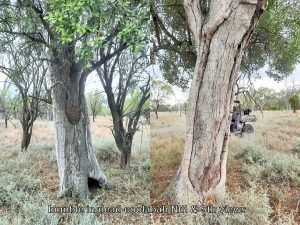
Ive talked about “Arbotecture” (Arborists + Architects) before ie how the people grew some of their shelters (Gunyahs, Goondies & Wurleys) & populated the camps with the desired vegetation varieties and shapes. Sandra has lent me a book on Aboriginal architecture by Paul Memmott so will be better informed when Ive read that. The semi nomadic nature of the people out here meant they moved camps in accordance with the predictable seasons & unpredictable weather. Really, the macro & micro management of country has to be seen to be believed – the problem is that its never seen.
